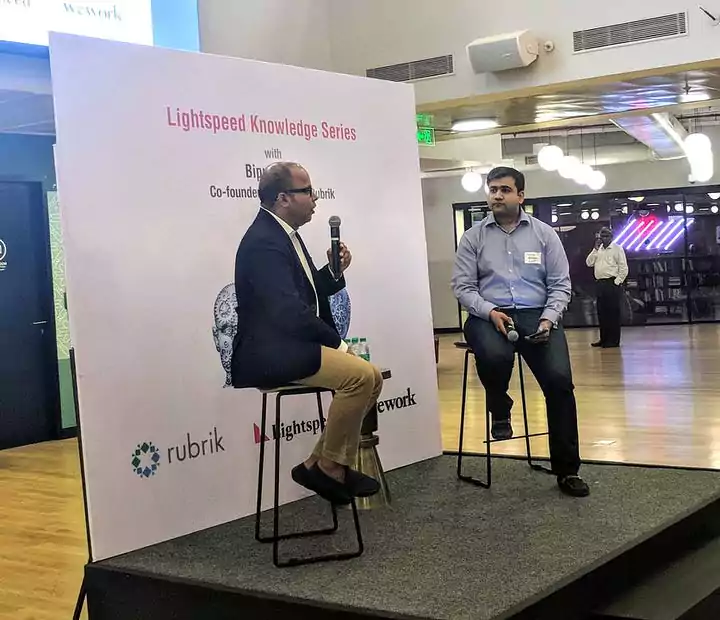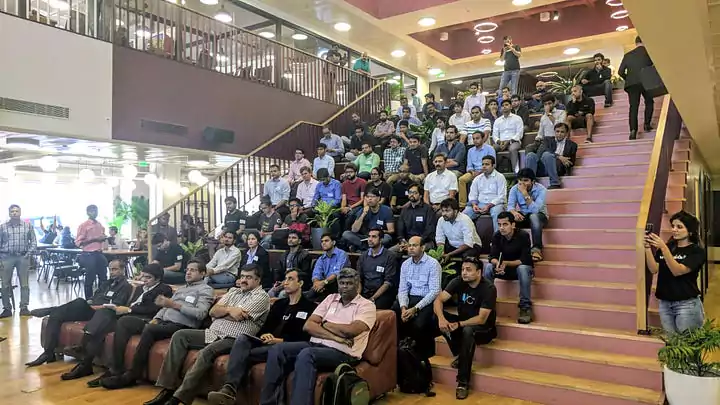01/14/2018
Enterprise
Engineering Hypergrowth at Rubrik: from Zero to nearly $300 million in Revenue in Four Years
In the latest edition of the Lightspeed Knowledge Series, we hosted Bipul Sinha, CEO and co-founder of Rubrik, who chatted with Akshay Bhushan, partner at Lightspeed, and 80 founders. We leverage Lightspeed’s network of portfolio companies in the United States, China, Israel and India to assist and provide guidance to our portfolio companies as well as to expose Lightspeed global portfolio founders, such as Dheeraj Pandey of Nutanix and Nic Cary of Blockchain.com, to the founder community in India.
First, a bit about Bipul and his experience in enterprise technology.

Bipul grew up in Bihar, studied Electrical Engineering at IIT-KGP and moved to work as an engineer in the US. He spent eight years at Oracle, post which he moved into venture capital, initially at Blumberg Capital and later as a partner at Lightspeed. He invested in Hootsuite, Nutanix and Pulse, amongst others, before co-founding Rubrik in 2014. Rubrik was incubated at Lightspeed and in less than four years, it has gone from zero to 1100 employees and is approaching a $300 million run rate, while having raised $292 million in funding.
We’ve put together some of the learnings from the talk here:
Strategy: Pick a Sector That Has Not Seen Innovation for a Long Time
The seeds for Rubrik were planted in Nutanix board meetings when backup and recovery came up as a laggard space. Bipul met more people to better understand the space and learnt that the space was 20–30 years old but there hadn’t been any innovation in it for least a decade. He realised that identifying and targeting a market that has been static for over a decade is a good strategy for startups to have. There are many such static segments in the enterprise technology market.
Strategy: Take Calculated Risks
Rubrik has been one of the fastest growing enterprise companies ever and this was ingrained in the culture in the beginning says Bipul, “We wanted to build the biggest company the fastest. We were thinking about ways to we accelerate the business — we thought of ways to put some capital at risk that could change the game. In a startup you’re either growing fast or dying — you need to keep accelerating.”
Bipul mentioned that it’s important to make such mistakes and learn quickly, “If you’re not making mistakes, you’re not taking risks. Taking risks should be a deliberate choice — if you’ve raised $10mn you should take $1mn and use it to take risks”
Strategy: Pick the Right Investors
You should pick someone who gets what you’re doing and understands your space but a partner who understands the importance of risks. In Bipul’s words, “90% of VCs don’t know what they’re doing. You shouldn’t get enamoured by money or valuations — none of it matters. Do your homework. Pick someone who knows your space but pick someone who is a bit of a dreamer. You need their support when you want to take risks.”
Product-Market Fit: Sell Before You Build

According to Bipul, a big risk in startups is “will the dog eat the dog food?” i.e.will the market actually pay for this product? To counteract this you must focus on the customer, listen to them and understand how they would perceive your product. Though they had a general idea as to who they wanted to target, the process to arrive at an actual product took almost 9 months. For this, Rubrik actually cold called and pitched customers as if they had a real product already. Based on the response they would edit the pitch and test what would work best with customers. Bipul says, “we actually did 60 customer calls before we even had a product and we even sold $350K worth of beta product before it became generally available.” He adds that “this process is about identifying where the actual pain is — you need to drive messaging towards that. If you don’t you can meander for years.” This reminds me of Amazon’s strategy to put together a draft press release for products it has yet to build.
Team Building: Pitch the Problem and Impact
Bipul candidly speaks about the difficulty in making the first few hires, “I thought I’m a hot shot VC so it’ll be easy to get people to follow me but 45 days later I’m waking up sweating in the middle of the night wondering what I did to my career because we had made no hires. I had exhausted all my contacts, all my connections.” Rubrik had a goal to build an engineering team better than the Google search infra team but were finding it hard to convince people to join. To solve this, they created a pitch deck to sell Rubrik to prospective employees. Bipul explains how they accelerated hiring — “I would sit at a coffee shop next to the Google campus all day and cold call people on LinkedIn back to back.” He needed to explain to prospective hires why they should join in terms that would be exciting to them e.g. what technical problems they’ll solve and what impact the company will make.
Team Building: Hire High Intensity People who are Better than the Founders
Speaking about what Bipul looks for in talent, he says “I define the people we look to hire as angry people, people who want to prove something to the world, people who when they go out to sell will either walk out with a purchase order or burn the building down.”
He adds that if you find people who are better than yourselves and are the kind of people you need to hire, you should go out and recruit them with urgency and intensity. For example, Rubrik has held baby showers for engineers’ spouses to convince them to join Rubrik.
Team Building: Build Trust in the Organization through Transparency
While many entrepreneurs understand the importance of transparency, it’s difficult to actually create a truly transparent organisation. This was really important to Rubrik according to Bipul — “We wanted to create the highest possible level of transparency we opened up board meetings to every Rubrik employee. This means that there is little information asymmetry and no one can use information as power. In fact, now everyone demands transparency and this allows everyone to move in the same direction at high speed. The next challenge for us is how to maintain it as we go from 1000 to 10000 employees”.
Selling: Go Big on Day One
While they were building the product, Rubrik set a timeline to release and decided to release it at VMworld. They decided to spend a quarter of a million dollars for sponsorship at the event before they had a product ready. According to Bipul, “the thought behind this was to create a large top of the funnel. We knew that unless we have a demand generation engine that we can use to attack we could never accelerate. We had 3000 people in the room for our release and by then we were ready with 6 sales teams across the country to take those leads and prosecute on them.”
Selling: Construct the The Right Incentives
This mindset also allowed them to grow sales rapidly. They want the sales team to push the boundaries of what success means so they innovated on incentives. Bipul explains, “In the first quarter, we set very modest quotas and for every dollar someone got beyond the quota they would make two dollars. Hence, people took it as a chance to make as much in a quarter as they do in a year. In 2 quarters we completely understood how much and how quickly a single salesperson can really sell because everyone worked hard to squeeze sales cycles.”
People said that a young startup can’t sell a million dollar deal. So Rubrik ran another experiment where if someone sold a million dollar deal they would get a 100K bonus. “In the 3rd quarter someone sold it. In the next quarter they sold a $2mn dollar deal. And three quarters away someone sold a $7mn deal. It was about opening people’s minds to possibilities and pushing things to a limit — we want everyone to try to achieve the impossible every time.”, explains Bipul.
Selling: Start Working with Partners Earlier than You Feel Comfortable
One mistake Bipul admits they made is not working with partners earlier. He felt that they shouldn’t work with partners so that they could control their own outcomes. A couple of years in they realised they were not getting enough leverage in the market since no one else was selling the Rubrik story.
If you’re building a fast growing technology company, we would love to talk to you.
We regularly host events for founders and other members of the ecosystem such as the Lightspeed Knowledge Series, Startup Office Hours, dinners and others. To stay updated, follow us on Twitter here.



